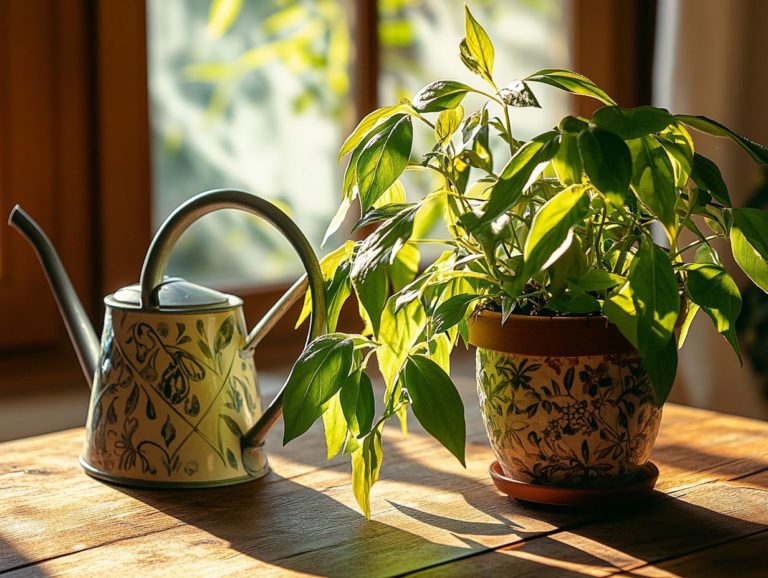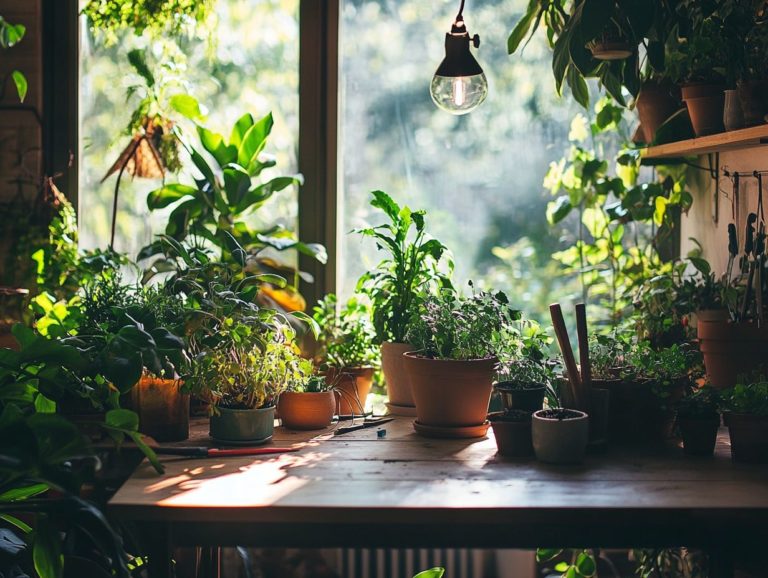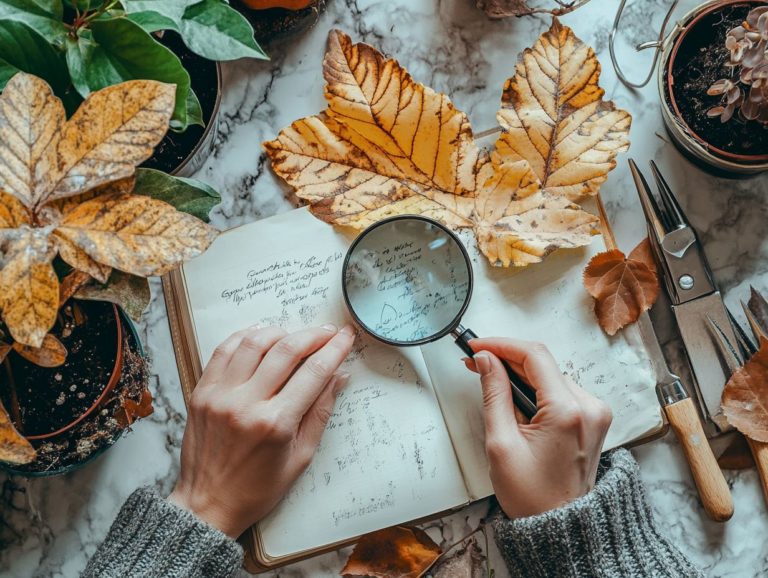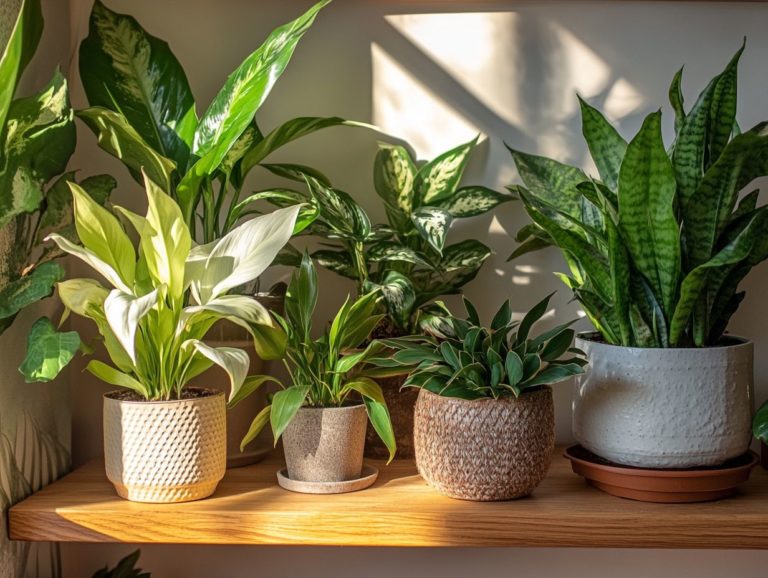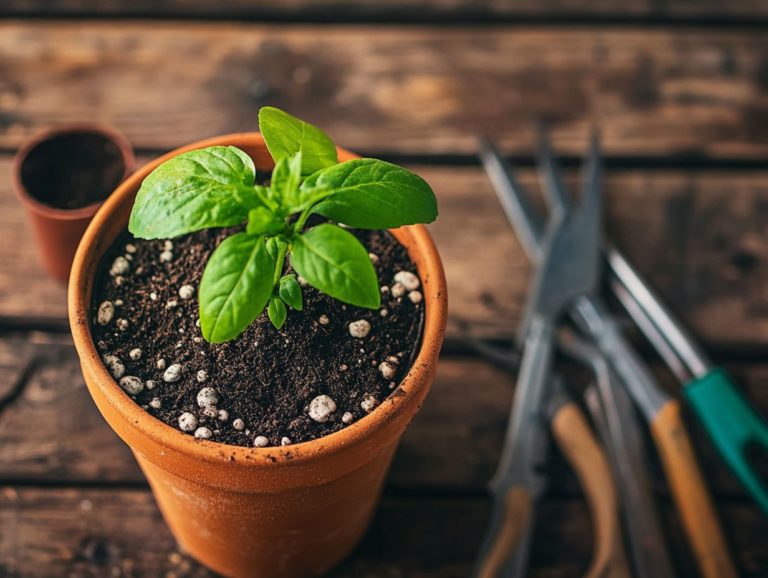What to Do When My Plant Leaves are Yellow?
Yellow leaves on your plants can often feel like a gardener’s worst nightmare, hinting at distress and potential problems lurking beneath the surface.
To maintain the lushness of your greenery, it s essential to understand the causes behind this common issue. Nutrient deficiencies, environmental factors, pests, and diseases can all contribute to the struggles your plants may face.
Get ready to restore your garden s beauty and watch it thrive like never before!
Contents
- Key Takeaways:
- Understanding Yellow Leaves on Plants
- Common Nutrient Deficiencies that Cause Yellow Leaves
- Identifying and Correcting Nutrient Deficiencies
- Environmental Factors that Cause Yellow Leaves
- How to Address Environmental Issues
- Pests and Diseases that Cause Yellow Leaves
- Preventing Yellow Leaves and Promoting Healthy Plants
- Reviving Plants with Yellow Leaves
- Frequently Asked Questions
Key Takeaways:
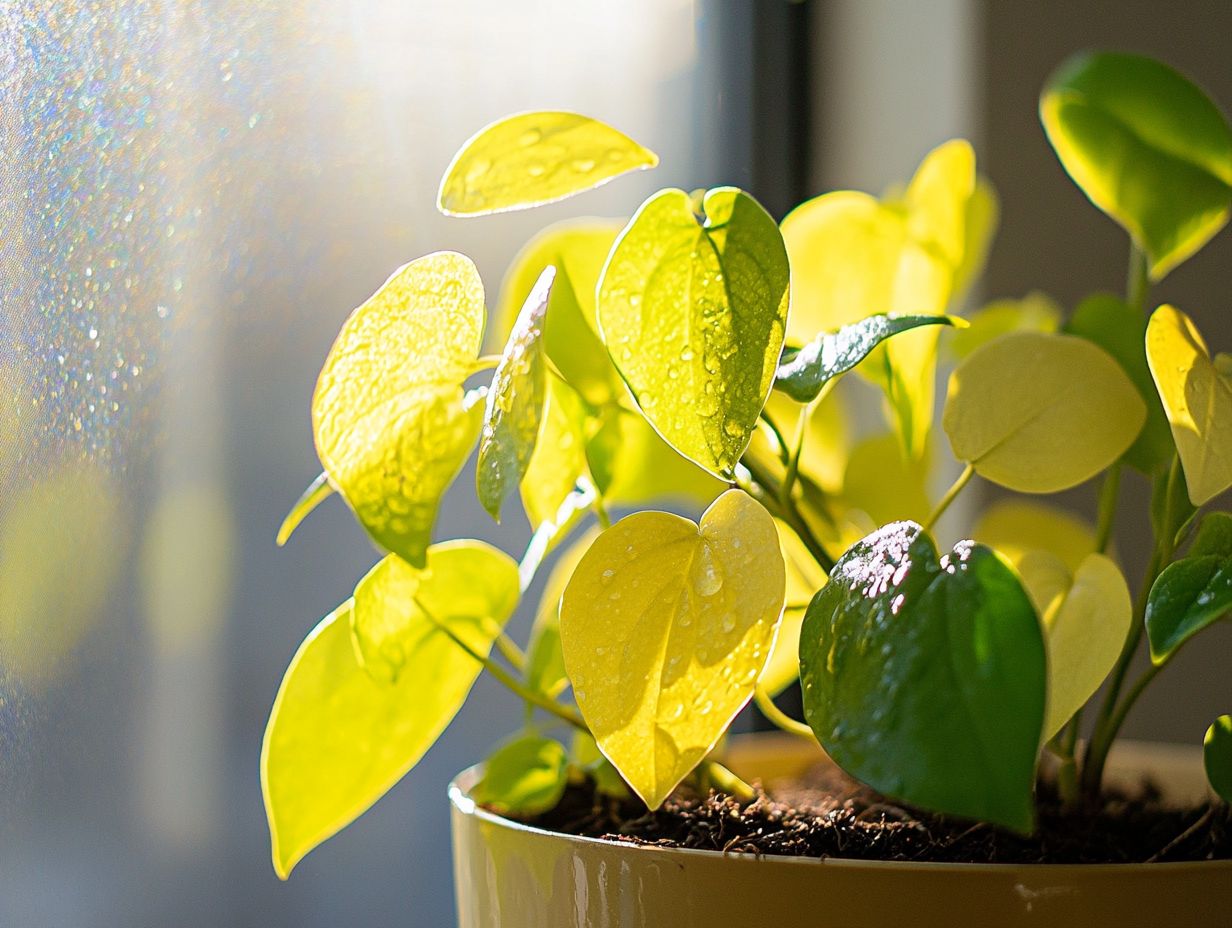
- Yellow leaves on plants can be caused by various factors, including nutrient deficiencies, environmental issues, pests, and diseases.
- Check your plants for signs of nutrient deficiencies and provide the needed nutrients through fertilizers.
- Proper plant care and maintenance, such as watering, pruning, and pest control, can prevent yellow leaves and promote plant health.
Understanding Yellow Leaves on Plants
Understanding the reasons behind yellow leaves on your indoor plants is essential for preserving their health and vibrancy. Yellowing can signal a variety of underlying concerns, such as nutrient deficiencies, improper watering, or environmental stresses that impact the overall wellbeing of your houseplants.
Pay attention to external factors like sunlight exposure and soil drainage to prevent yellowing leaves, enhancing your indoor gardening experience significantly.
Possible Causes
Several factors can lead to the yellowing of leaves in your houseplants, including improper watering practices, root damage, and nutrient deficiencies. Overwatering can result in poor soil drainage, paving the way for root rot and jeopardizing your plant s health.
On the flip side, underwatering deprives your plants of essential moisture, leading to those dreaded yellow leaves. Add in temperature fluctuations and inadequate sunlight exposure, and your plants can become stressed, exhibiting symptoms of yellowing leaves.
Keep a close eye on your soil moisture levels to ensure your plants thrive! Each plant variety has specific requirements. For instance, cacti flourish in drier conditions, while ferns love consistently moist soil. Consider using a moisture meter to eliminate the guesswork.
Remember, soil conditions matter too; an ideal mix drains well yet retains some moisture, catering to the needs of most houseplants. Implementing proper moisture management practices further ensures your plants thrive.
Pay close attention to your plant s environment. Sudden drafts or inconsistent room temperatures can stifle growth, and insufficient light can hinder their ability to photosynthesize effectively, contributing to leaf yellowing.
Gardening enthusiasts stress the importance of a proper care routine, including repotting plants when necessary. Adjusting these elements can significantly elevate your plants vitality.
Common Nutrient Deficiencies that Cause Yellow Leaves
Nutrient deficiencies frequently play a significant role in the appearance of yellow leaves on indoor plants, with each deficiency presenting unique symptoms that can inform your houseplants care choices.
For example, a nitrogen deficiency often results in the yellowing of older leaves, while an iron deficiency typically causes yellowing leaves with green veins still intact. Understanding these subtleties is crucial for anyone passionate about nurturing their houseplants.
By pinpointing specific nutrient deficiencies and addressing them with the appropriate amendments or fertilizers, you can revitalize your plants and enhance their overall health. Understanding plant nutrition is key to this process.
Identifying and Correcting Nutrient Deficiencies
Identifying nutrient deficiencies in houseplants is essential. It helps keep their foliage vibrant and healthy.
By understanding the signs and symptoms of deficiencies like leaf discoloration and stunted growth you can take proactive steps to refine your plant care practices.
Utilizing soil tests and watching for chlorosis, a condition where leaves turn yellow due to nutrient deficiencies, can reveal which nutrients are lacking. This allows you to implement effective fertilization strategies tailored to specific plant species.
This proactive approach not only nurtures healthy plants but also elevates your enjoyment of indoor gardening.
To accurately diagnose nutrient deficiencies, it s invaluable to monitor visible symptoms and test your soil often. These tests provide insights into pH and nutrient levels, offering a comprehensive picture of what might be missing.
Pay attention to changes in leaf texture and shape. For instance, curling or browning edges often point to specific nutrient shortfalls.
Once you ve identified the deficiencies, adjusting your fertilization methods such as incorporating organic matter or slow-release fertilizers can create a balanced nutrient supply.
Try crop rotation and companion planting to enhance nutrient availability over time. These methods ensure your plants stay lush and thriving.
Environmental Factors that Cause Yellow Leaves
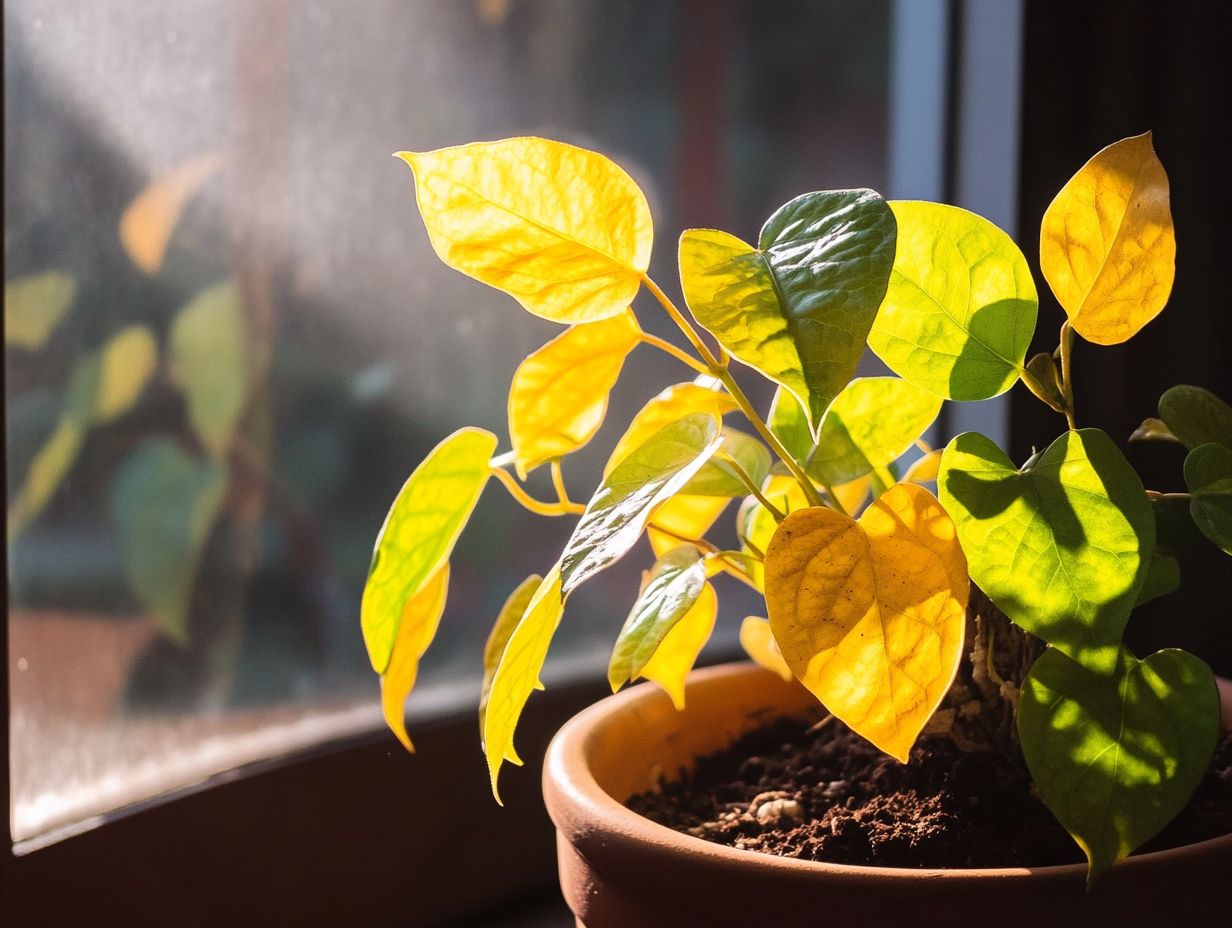
Environmental factors significantly influence the health of your indoor plants. Grasping these elements is crucial for preventing pesky yellow leaves.
Consider aspects like temperature fluctuations, humidity levels, and sunlight exposure. They can directly affect your plant’s ability to flourish, resulting in a range of leaf issues.
For example, extreme heat or cold can induce stress, while insufficient humidity can lead to dryness, adversely impacting overall plant health. Recognizing signs of environmental stress helps you make necessary adjustments to cultivate a more nurturing indoor gardening environment.
Avoiding chemical exposure to your plants can also help maintain their health.
How to Address Environmental Issues
Addressing environmental issues is vital for maintaining the health of your houseplants and preventing unsightly yellowing leaves. By implementing effective gardening practices like ensuring they receive adequate sunlight, regulating temperature, and managing humidity you can significantly enhance their overall health.
Two critical aspects to monitor are light intensity and duration. Different plants have unique light requirements. Position your sun-loving varieties near west or south-facing windows to provide the brightness they crave.
Aim for a comfortable temperature range between 65 F to 75 F for most houseplants. Utilizing thermostats or temperature gauges can help you achieve this optimal environment.
You might also consider moisture meters to accurately assess humidity levels, ensuring your plants receive just the right amount of moisture.
Try grouping your plants together! This simple strategy can boost humidity and keep them happy. By staying vigilant and making these thoughtful adjustments, you can nurture vibrant, thriving plants that bring life to your indoor space.
Pests and Diseases that Cause Yellow Leaves
Pests and diseases pose significant threats to the health of your beloved houseplants. They often reveal themselves through telltale signs such as yellow leaves and discoloration.
Common culprits like aphids and spider mites can stealthily drain sap from your plants, leading to stunted growth and symptoms of chlorosis.
Fungal infections can wreak havoc in your indoor oasis, leading to yellowing leaves and, if left unchecked, a decline in plant vitality. Recognizing these signs of pest infestations and plant diseases is crucial to provide effective care and keep your indoor garden thriving!
Identifying and Treating Common Plant Pests and Diseases
Identifying and addressing common plant pests and diseases is essential for ensuring the longevity of your houseplants and preventing unsightly yellow leaves. Observing changes in leaf color and texture, recognizing infestations, and understanding the symptoms of fungal infections are critical steps in effective plant maintenance.
Once you’ve pinpointed the issue, using solutions like insecticidal soaps, neem oil, or suitable fungicides substances that kill fungi that harm plants can help you eradicate pests and diseases and restore your plants to their vibrant selves. Incorporating regular inspections into your comprehensive care routine can significantly boost your plants’ resilience.
Watch environmental factors closely, such as humidity, temperature, and soil quality. This will provide valuable insights into potential vulnerabilities within your plants’ ecosystem. Using pest traps and sticky pads can aid in early detection. Ensuring adequate air circulation around your plants minimizes the risk of fungal growth.
You should also focus on preventive measures, such as:
- Rotating crops
- Ensuring proper watering practices
- Integrating beneficial insects like ladybugs
By prioritizing these strategies, including plant maintenance and gardening solutions, you can cultivate a thriving environment that supports the overall health and vitality of your plants.
Preventing Yellow Leaves and Promoting Healthy Plants
Preventing yellow leaves demands a proactive approach to your plant care routine. This includes proper watering, providing the right nutrients for your plants, and effective pest control. By adopting sound gardening practices like ensuring your plants receive adequate sunlight and optimal soil drainage you can cultivate healthier plants and significantly reduce the risk of leaf discoloration.
Consistently monitor for pests and diseases. Adjusting environmental conditions also plays a pivotal role in maintaining vibrant foliage. With a thoughtful strategy, you can minimize the chances of yellowing leaves and enhance your indoor gardening experience, making it truly rewarding.
Proper Plant Care and Maintenance
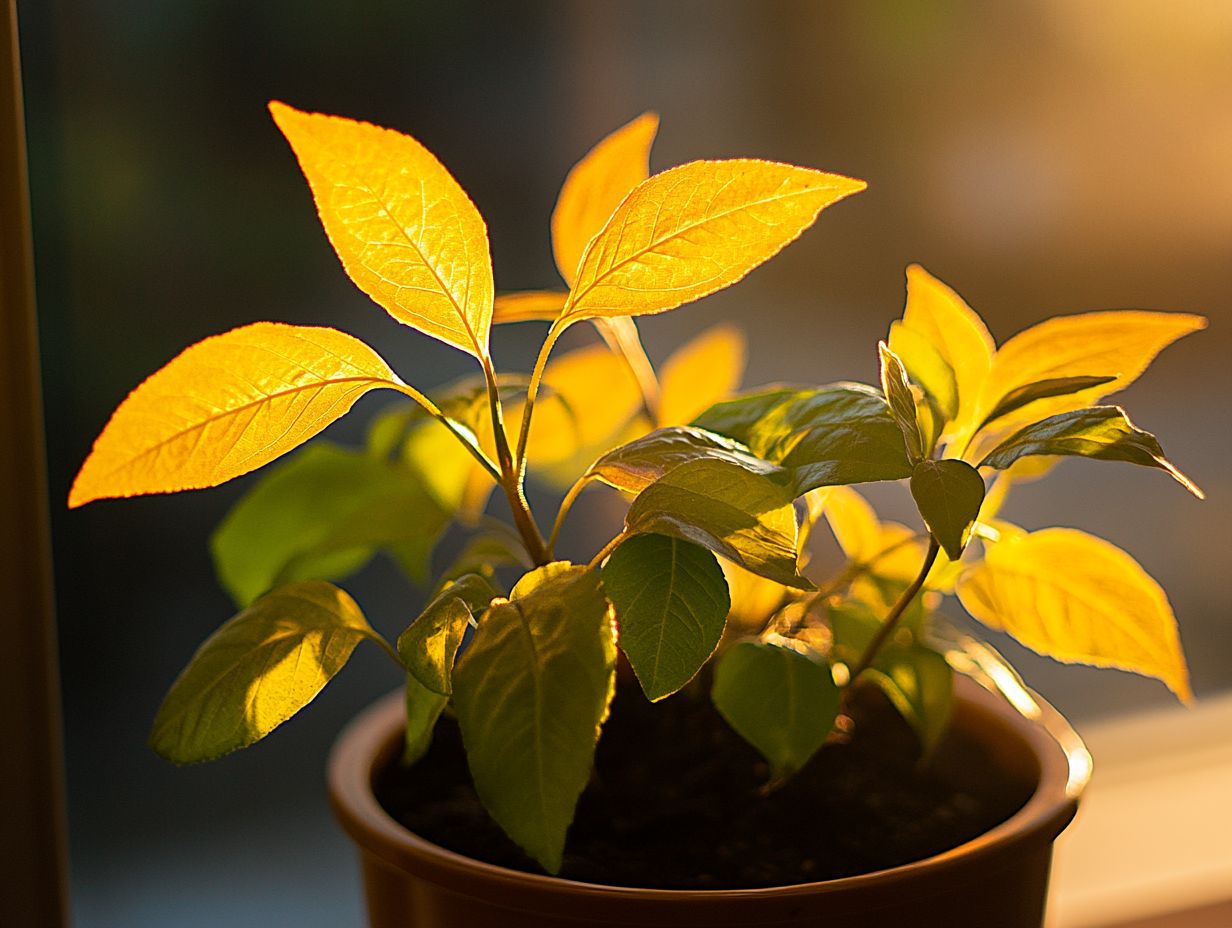
Proper plant care and maintenance are crucial for ensuring your houseplants thrive and keeping those pesky yellow leaves at bay. By implementing effective watering practices like determining the right frequency and ensuring proper soil drainage you can significantly enhance your plants health.
Opting for the right potting soil and incorporating fertilizer as needed will guarantee that your indoor plants receive the essential nutrients they crave. Following expert gardening advice and creating a tailored care routine based on the specific needs of each plant species is paramount for cultivating a flourishing indoor garden.
It s crucial to know how to assess when your plants need water. Overwatering is often the sneaky villain behind unhealthy foliage. Using a moisture meter or simply inserting a finger a couple of inches into the soil can provide insight into their hydration needs.
Choosing a high-quality potting mix rich in organic matter will improve moisture retention and ensure adequate aeration. During the growing season, applying liquid fertilizer will supply the necessary nutrients, fostering growth and vibrancy.
Regularly check for signs of pests or disease to keep your indoor plants thriving and to prevent any deterioration along the way.
Reviving Plants with Yellow Leaves
Reviving plants with yellow leaves demands a thoughtful strategy. This centers on pinpointing the underlying cause of the issue and taking the necessary corrective measures.
Whether the yellowing stems from overwatering, nutrient deficiencies, or environmental stressors, understanding these fundamental factors is vital for restoration. Implement tailored care solutions like fine-tuning watering schedules, improving soil drainage, or modifying light exposure to breathe new life into struggling plants and restore their vibrant allure.
Through proactive problem-solving, you ll cultivate a thriving indoor garden that reflects resilience and success.
Steps to Restore Health and Greenery
To bring back the health and greenery to your plants, especially those with yellow leaves, follow these actionable steps. Start by assessing your plant’s environment check the light, temperature, and humidity levels to ensure they support growth.
Next, evaluate your watering routine and soil conditions. Ensure you have proper drainage and the right nutrients in the soil.
These evaluations give you critical insights into your plants’ specific needs. Adjusting environmental conditions, like moving plants to brighter spots or tweaking humidity levels, can make a big difference.
Pay close attention to your watering habits. Overwatering or underwatering can lead to yellow leaves.
Managing nutrients is equally important. Use balanced fertilizers to replenish the essential elements your plants may lack.
Regularly check for pests. Identifying issues quickly will help keep your plants vibrant and lush.
Frequently Asked Questions
What to Do When My Plant Leaves are Yellow?
If your plant leaves are turning yellow, it may signal a health issue. Here are some common questions to help you address the problem.
Why are my plant leaves turning yellow?
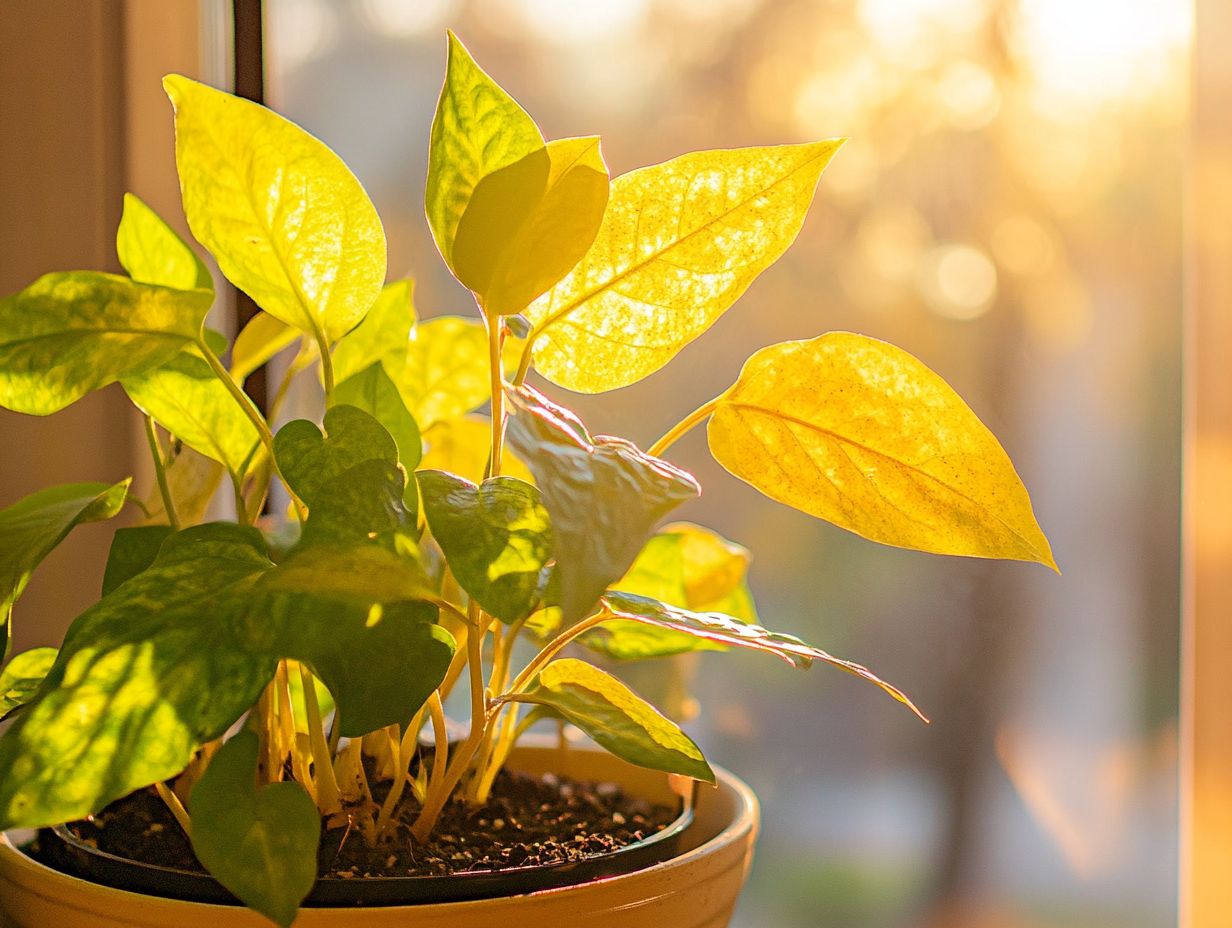
Yellow leaves can arise from overwatering, lack of nutrients, pest infestations, or diseases. Identifying the cause is crucial for effective treatment.
How do I know if my plant needs more or less water?
Overwatering is a common reason for yellow leaves. To check, stick your finger about an inch into the soil. If it’s dry, water your plant. If it’s moist, wait a few days before watering again.
What should I do if my plant has a nutrient deficiency?
If yellow leaves indicate a lack of nutrients, fertilize with a balanced fertilizer. First, identify which nutrient is missing to choose the right product.
How can I prevent pest infestations on my plants?
Pests like spider mites and aphids can cause yellow leaves. Regularly inspect your plants for signs of pests, and remove affected leaves. Consider using natural methods like neem oil or insecticidal soap to control them.
Should I remove the yellow leaves from my plant?
It’s best to remove yellow leaves, as they can attract pests. However, if yellowing is due to nutrient deficiency, address that issue first before taking off the leaves.

